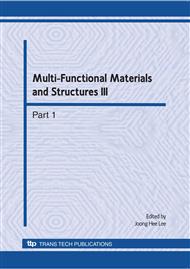p.551
p.555
p.559
p.563
p.567
p.571
p.575
p.579
p.587
Numerical Analysis on the Compressive Behaviors of Aluminum Foam Material Using Computed Tomography Imaging
Abstract:
In the present study, we used computed tomography (CT) images of aluminum foam material obtained by an industrial volume CT system for a numerical analysis of the compressive behavior of the material. A three-dimensional model of aluminum foam was developed by stacking the CT images. The simulated and experimental compressive behaviors were compared. In particular, the simulated compressive behaviors were compared with those of experiments using various strain rates in order to verify the accuracy of the three-dimensional model. The results showed that the simulated compressive stress-strain curve displayed a similar tendency to that of the experiment, but had a higher compressive strength. The results also showed that the simulated compressive deformation pattern displayed a similar tendency to those of the experiments for all strain rates, and the deformation was significantly affected by the simulation of pore shape and size.
Info:
Periodical:
Pages:
567-570
Citation:
Online since:
August 2010
Authors:
Price:
Сopyright:
© 2010 Trans Tech Publications Ltd. All Rights Reserved
Share:
Citation:


